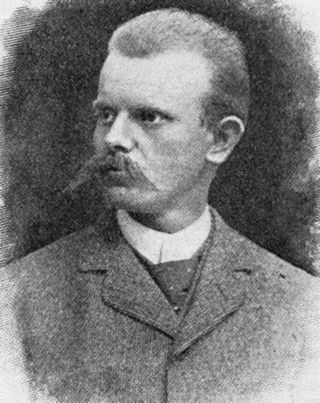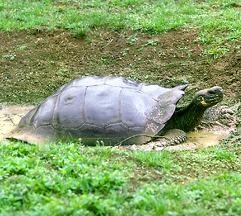
Tortoises are reptiles of the family Testudinidae of the order Testudines. Like other turtles, tortoises have a shell to protect from predation and other threats. The shell in tortoises is generally hard, and like other members of the suborder Cryptodira, they retract their necks and heads directly backward into the shell to protect them.

Giant tortoises are any of several species of various large land tortoises, which include a number of extinct species, as well as two extant species with multiple subspecies formerly common on the islands of the western Indian Ocean and on the Galápagos Islands.

The Pinta Island tortoise, also known as the Pinta giant tortoise, Abingdon Island tortoise, or Abingdon Island giant tortoise, is a recently extinct subspecies of Galápagos tortoise native to Ecuador's Pinta Island.
Pinzón or Pinzon Island is an island in Ecuador's Galápagos Archipelago. It has no permanent population, an area of 18 square kilometers (6.9 sq mi), and a maximum elevation of 458 meters (1,503 ft). Home to giant Galápagos tortoises of the subspecies Chelonoidis duncanensis and Galápagos sea lions, the island has no visitor facilities and a permit is required for legal visits.

Georg Baur (1859–1898) was a German vertebrate paleontologist and Neo-Lamarckian who studied reptiles of the Galapagos Islands, particularly the Galápagos tortoises, in the 1890s. He is perhaps best known for his subsidence theory of the origin of the Galapagos Islands, where he postulated the islands were the remains of a former landmass, connected to South America via Cocos Island.

The Galápagos tortoise or Galápagos giant tortoise is a very large species of tortoise in the genus Chelonoidis. The species comprises 15 subspecies. It is the largest living species of tortoise, and can weigh up to 417 kg (919 lb). They are also the largest extant terrestrial cold-blooded animals (ectotherms).

Elseya is a genus of large side-necked turtles, commonly known as Australian snapping turtles, in the family Chelidae. Species in the genus Elseya are found in river systems in northern and northeastern Australia and throughout the river systems of New Guinea. They are identified by the presence of alveolar ridges on the triturating surfaces of the mouth and the presence of a complex bridge strut.

Chelonoidis is a genus of turtles in the tortoise family erected by Leopold Fitzinger in 1835. They are found in South America and the Galápagos Islands, and formerly had a wide distribution in the West Indies.

The Chaco tortoise, also known commonly as the Argentine tortoise, the Patagonian tortoise, or the southern wood tortoise, is a species of tortoise in the family Testudinidae. The species is endemic to South America.
Extinct or Alive is an American wildlife documentary television programme produced for Animal Planet by Hot Snakes Media of New York City, the United States. It is hosted by wildlife biologist and television personality Forrest Galante, who travels to different locations around the globe to learn about possibly extinct animals and whether or not there is a chance that they may still be extant. The series has been involved in the possible rediscovery of eleven animals, namely the Zanzibar leopard, the Pondicherry shark, the Fernandina Island Galápagos tortoise, the Miller's grizzled langur, the Cape lion, the Malagasy hippopotamus, the Yangtze giant softshell turtle, Rio Apaporis caiman, Whitetip weasel shark, Ornate sleeper-ray and the Flapnose houndshark.

Forrest Galante is an American wildlife biologist, outdoor adventurer and television personality. He primarily seeks out animals on the brink of extinction. He is the host of the television shows Extinct or Alive on Animal Planet and "Mysterious Creatures with Forrest Galante," as well as multiple Shark Week shows.
Giant tortoises are any of various large land tortoises

The Santiago Island giant tortoise, also known commonly as the Santiago giant tortoise and the James Island tortoise, is a subspecies of Galápagos tortoise in the family Testudinidae. The subspecies is endemic to Santiago Island in the Galápagos.

Chelonoidis niger chathamensis, commonly known as the Chatham Island giant tortoise or the San Cristóbal giant tortoise, is a subspecies of Galápagos tortoise endemic to San Cristóbal Island in the Galápagos.

The Floreana giant tortoise, also known as the Charles Island giant tortoise, is an extinct subspecies of the Galápagos tortoise endemic to the Galápagos archipelago in the equatorial eastern Pacific Ocean. The specific epithet niger (‘black’) probably refers to the colouration of the holotype specimen. The species name has often been misspelled as nigra, an error introduced in the 1980s when Chelonoidis was elevated to genus and mistakenly treated as feminine, an error recognized and fixed in 2017.

The Santa Fe Island tortoise, also known as the Santa Fe tortoise or Santa Fe giant tortoise, is an undescribed extinct taxon of Galápagos tortoise endemic to Santa Fe Island in the Galápagos archipelago in the equatorial eastern Pacific Ocean. Evidence for the historic existence of the tortoise comes from 19th century anecdotes of whalers and settlers removing tortoises from the island, as well as the discovery of tortoise bones there by the 1905–1906 California Academy of Sciences expedition, with genetic examination of the bones indicating that they belonged to a unique taxon most closely related to Chelonoidis niger hoodensis, the Hood Island giant tortoise from Española Island.
Chelonoidis alburyorum is an extinct species of giant tortoise that lived in the Lucayan Archipelago from the Late Pleistocene to around 1400 CE. The species was discovered and described by Richard Franz and Shelley E. Franz, the findings being published in 2009.
Chelonoidis cubensis, also known as the Cuban giant tortoise, is an extinct species of land tortoise that lived in Cuba from the Late Pleistocene to the Early Holocene. It had a carapace length of between 40 cm and 90 cm. It is thought that the species went extinct through human exploitation.
Chelonoidis monensis, also known as the Mona tortoise, is an extinct species of land tortoise that lived on the island of Mona from the Late Pleistocene to around 1000 BCE. Evidence for the latter date includes cave drawings. All fossil remains have been found either in or near Liro Cave on the east side of Mona. It had a carapace length of around 50 cm (20 in).















